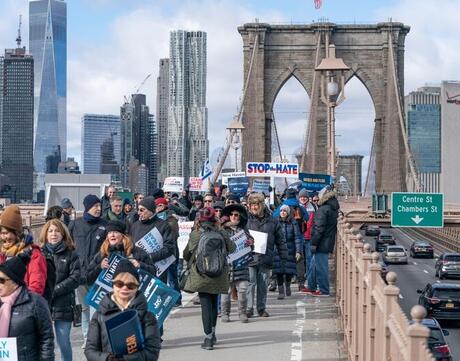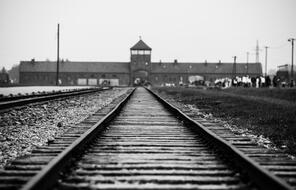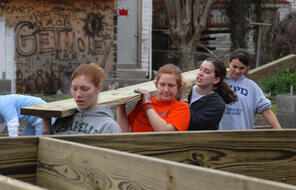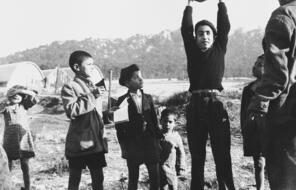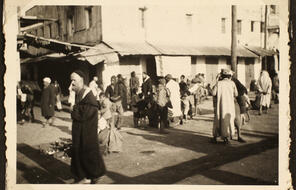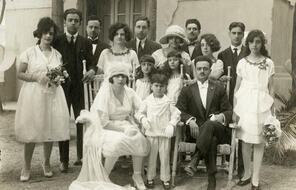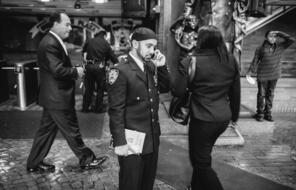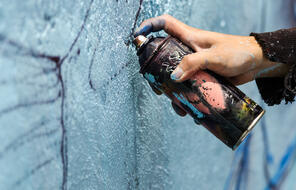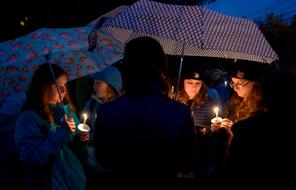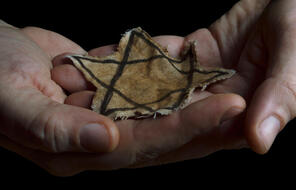Before class, set up for a Gallery Walk by printing the following excerpts from different news articles and posting them around your classroom. (Note: If you are teaching remotely, share the four excerpts below with your students, and ask them to reflect on the discussion questions individually or in pairs online with a classmate).
Article 1: Washington Post, Do We Have the Courage to Stop Anti-Semitism’s Rise Once Again?
The ranks of people old enough to have witnessed the final throes of the world’s deadliest catastrophe [World War II and the Holocaust] are dwindling daily, marching into the past.
When the last of them cross into history, these memories, and the meaning of these events, will be kept alive only by acts of will and conscious choices. Who will choose to spend time with such ugliness and sorrow? To confront what happened, to admit it and learn from it, requires one to linger in the dank recesses of the human soul, to stare at things that decency normally ignores.
Article 2: Washington Post, Acts of Anti-Semitism Are on the Rise in New York and Elsewhere, Leaving Jewish Community Rattled
Anti-Semitic attacks are on the rise around the country, leaving members of the Jewish community feeling frightened and unsafe. In New York City, anti-Semitic crimes have jumped 21 percent in the past year. According to the Anti-Defamation League, there were 1,879 incidents of anti-Semitism in the United States in 2018, including more than 1,000 instances of harassment.
“This is a national phenomenon that we are seeing and it’s frightening and it’s disturbing,” [New York Governor] Cuomo said at a news conference Sunday. “If anyone thinks that something poisonous is not going on in this country, then they’re in denial.”
Experts say anti-Semitic violence has been rising for years. In 2018, a gunman stormed Pittsburgh’s Tree of Life synagogue, killing 11 congregants and wounding six others. It was the deadliest anti-Semitic attack in the history of the United States.
Article 3: Wall Street Journal, Rise in Anti-Semitic Incidents Goes Beyond Recent Violent Attacks
As of September, anti-Semitic hate crimes in New York City—home to the U.S.’s largest Jewish population—were up 51% this year from the same period last year, according to New York Police Department data. That included a string of assaults against Orthodox Jews in Brooklyn, as well as a sharp rise in anti-Semitic subway graffiti . . .
For some Jews, the abrupt rise has been jarring—something they never thought they would have to deal with in the modern U.S.
Rabbi Stewart Vogel, president-elect of the Rabbinical Assembly, the international organization of Conservative rabbis, said he never thought he would give a sermon on anti-Semitism, which he had considered a vestige of the 1930s and ’40s in the U.S. At age 60, it wasn’t something he had seriously dealt with—until recently.
“It creates a vulnerability that our community has not felt in several generations,” he said.
Article 4: Christian Science Monitor, Why Anti-Semitism is Surging across the Political Spectrum
“We are in some ways where we have always been, which is that humans are prewired to see an us and a them,” says Ken Stern, an expert on anti-Semitism at Bard College in New York. “And there are lots of messages in society from politics, from media and other places, that reinforce that sort of view of the world – that we’re not all one big happy human family, but we are looking and highlighting and searching for differences.”
“Anti-Semitism is one of those manifestations of that world view,” continues Professor Stern, “because historically Jews are seen as an other, a danger, and conspiring to harm non-Jews. We do know that when there is a glorification of the us versus them mentality, anti-Semitism is always going to rise.”
During class, ask your students to read the different excerpts and respond to them using the Big Paper Discussion teaching strategy. Students should circulate to the different readings and silently respond to them, using the following questions to guide their thinking:
- What information do you find surprising or troubling?
- What impact do antisemitic incidents have on people?
- Why do you think antisemitic incidents are on the rise?
After students have finished silently responding to the readings, ask them to return to their seats. Then discuss the following questions:
- In light of what you read, how do you think small acts of hate, such as graffiti or name-calling, impact communities? How could they make it more likely that people will commit violent acts?
- What factors contribute to a climate in which perpetrators of hateful acts feel emboldened?
